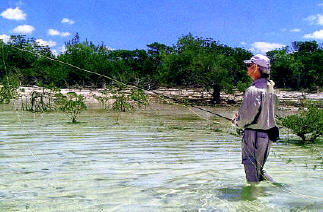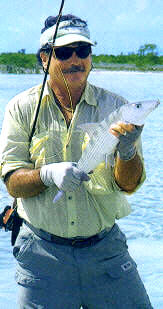July 02, 2012
By Frank Bolin
Around the southern tip of Andros unbelievable bonefish numbers stack the odds in favor of enjoying a grand ol' time—for both novices and experts.

Wading is the premier way to target bigger bonefish traveling in singles and pairs tight to the shore. The bottom is hard, but you'll need a good pair of wading shoes. |
Showed me the bonefishing light is what Reverend Felix Smith did, while introducing me to Andros' potential. Under the tutelage of this native South Andros, Kemp's Bay guide my conception of chasing flats ghosts did an about face, escalating from a take it-or-leave it attitude to enlightened convert. In two days I was baptized into the bonefish religion. Here's the take-away on bonefishing Andros.
On a mid-June morn, the Rev unveiled his plan: Run down Andros' southeast coast, slip around the tip—where we could hide from a stiff northeasterly breeze—and start searching for massive bonefish schools mudding on Jack Fish flat. As Smith slid between narrow mangrove channels, fishing buddy and wildlife sculptor Paul Baliker and I watched an expansive flats system come into view. Sea-foam green sandy bottom stretched for eternity. Rocky patches studded these shin-deep shallows, relief terrain interrupting current-rippled sands with small coral heads and spider-like outcroppings. “Bonefish paradise” is how Paul summed it up, “without another soul in sight.”
Learning Curves
Easing into a tucked-away bay, Smith shut down and poled the skiff toward shore. Then, he slipped quietly over the gunnel, grabbed a bowline and began walking the skiff along a tidal swash that had cut a groove into the bottom.
“We're scouting for muds,” the Rev informed us. “Bonefish come onto these flats to spawn in June and gather in huge schools.”
He wasn't kidding. After spotting a muddy circle 15 yards or so wide, we edged within casting distance and saw bones by the dozens flashing in and out of the moving opaque marl. Paul, a bonefishing vet, unsheathed his 8-weight fly rod, flipped a Crazy Charlie deep into the school, stripped once and got a hit. Not a big bone, but a feisty 2-pounder just the same. He let that fish go, then did it again, again and again. I, on the other hand, had yet to feel a tap on the pink, 1/4-ounce skimmer jig that I slowly crawled and hopped across the bottom using spin tackle. Fish parted ways to let my jig pass through.
Baliker's fourth fish prompted a switch to fly, even though wielding such equipment is not my forté. The bones just weren't hitting the jig, regardless of presentation. Tying on a pattern called a Bonefish Killer (a variation of the Crazy Charlie), my first cast into the mud found a taker. So did the second, third and fourth. Nothing to this bonefishing I thought. Drop a fly into the school, let it sink to the bottom, take a few 1-inch strips to impart action and strip set on the first slurper. Oh yeah, and remember to get your knuckles clear of fly-reel-handle harm before that first blistering run.
Smith kept us on mud patrol for much of the day, moving around the large island's southern end. For six hours, we worked Jack Fish, Curley Cut and Water Cay flats, sidestepping stingrays and nurse sharks while firing casts into bonefish schools bursting at the seams with ravenous 11/2- to 2-pounders.
The next day Rev announced a strategy change due to a switch in wind direction. Idling off the ramp, Smith nosed his 16-foot skiff into Litttle Creek. We would sight fish singles and pairs instead of muds—a graduation of sorts for me, old hat for Paul. Worming through the creek deep into Andros' southern core and emerging on its Gulf side, bonefishy habitat stretched everywhere. We whizzed past countless nooks and crannies brimming with mangrove-dotted shores, through narrow coral cuts and over prop-wrecking shallows sheathed by water so clear that they appeared too skinny to run. Smith emerged from the twisting channel into a series of protected flats that faintly resembled waters we worked the day prior except for tighter quarters, more mangrove shoots and countless reef patches.
Pulling into the lee of a wide cove immediately west of where Little Creek dumps into Rock Sound, the skipper instructed us to don wading shoes, fan out and work our way around the cove's curving circumference. That and not make a sound. Twenty yards up the beach, a silvery glimmer caught my eye and I shot a fly about two feet in front of the wavering glint. No mistaking that charge! A hefty bone struck my fly on the run, blasting off with afterburners firing toward a hump of razor-sharp reef. I tried, but couldn't turn the hefty fish before it reached the cutoffs, rooster-tailing all the way. At least I got to feel the power of a trophy bone before it parted my line.
Baliker, taking a nearshore track, started racking up releases. Pretty soon he had a dozen 2- to 3-pound Andros flats ghosts to his credit. The preacher's technique was foolproof: “Spot and ambush bones single-filing it past reef patches speckling the shoreline. Just lead ‘em and feed 'em.”
Fish constantly swam by us as we waded against the outgoing tide toward the back of the cove, offering a shot or two only if you stayed cocked and ready to fire an accurate 30-foot cast at moment's notice. One lesson I learned quickly was to forget unnecessary false casting. Pick your target and cast pronto with no wasted motion. One fleeting shot was the norm before these alert ghosts of the flats were history.
Later that afternoon, although my tally for the day couldn't compare to Paul's at 12 vs. 26, I couldn't wipe the grin off my face. My first two days of actually catching bonefish was, as Tony the Tiger growls, “Great!” Spotting, intercepting and feeding flies to these silvery flats speedsters had made me a believer.

The author moments after "seeing the light." |
Tackle and Times
From my experience, I recommend packing fly rods for this trip—a 5- or 6-weight for calm, glassy mornings and a 7- or 8-weight for when the breeze picks up. Most casts are within 20 to 40 feet, and in these clear waters excessive false casting is a detriment. Line shadow spooks these bones quickly. Pack an assortment of Crazy Charlies, Bonefish Killers, Gotchas and Bonefish Specials. These, and most pink or brown patterns were rarely refused.
For terminal tippets, bring several spools of 10-pound fluorocarbon or mono leader material. We tried 8-pound and kept losing fish to reef patches and mangrove shoots. When we tied on 12-pound, bites slowed down—even in mudding schools. Ten-pound shock tippet also ups the odds if you happen to hook into a hefty bone. Although most fish we released ran between 1 and 3 pounds, Paul hooked one whopper pushing 9 or 10 pounds that made short work of his 8-pound shock tippet.
Fishing spinning tackle is tricky. The concussion of a jig landing near chosen targets often spooks them.
Picking the right time for any South Andros bonefishing trip seems easy enough. Resident fish prowl these flats year-round. Choosing a date depends on what type of fishing you want to do, and how many release numbers you need to rack up. June and July are known for huge, mudding schools of little bones, primarily fish in the 1- to 2-pound class. Bruiser models also roam summer's extreme shallows, particularly early and late in the day when water temps are moderate.
From August until September, Bonefish Bay Resort latches its doors, as do many others during hurricane season. Not that bonefish are unavailable those months, but wind often keeps flats riled up and difficult to access. Smith hinted that bonefishing is best from October through February. That is if bones weighing above 5 pounds stretch your string. But, you have to play the weather. When it's calm, count on excellent bonefishing. When it's blustery, your skills had better be up to par.
Spring offers consistency. Schools often form in channels during ebb tide and once the tide turns to flood, beat it for the shallowest flats where they burrow for crabs and tail continually. Sometimes, Smith says, fish are so absorbed with rooting crustaceans from the bottom that it's possible to wade within 20 feet of a waving tail before casting your fly. When that occurs, drop the fly right on its head, let it sink and retrieve it in short, 1-inch strips. This action mimics small shrimp and crabs fleeing from danger.
First published in Florida Sportsman Magazine, November, 2005.
Click Here to Have Florida Sportsman Magazine Delivered to Your Home.
